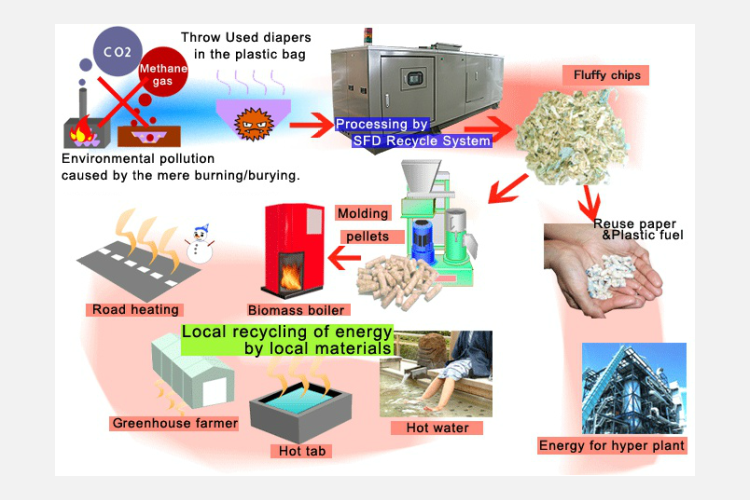Cogeneration Electricity Steam Electricity Again Spinning a Generator
Civilisation is nether threat. It seems clear that traditional methods of generating electricity are unsustainable and we must observe new means to generate electricity that practice not produce as much carbon (or dust off old ones, similar natural gas and nuclear power).
The need for alternative power sources isn't new. We've seen massive solar arrays unveiled in vast deserts, enormous on-and-offshore windfarms, wave-beams converting the ability of our oceans, and biomass solutions make it and disappear.
However, these forms of culling energy are not the simply game in town. Here are 10 new ways to generate electricity.
1. Harvesting Body Rut
Several major cities have established projects that harvest heat trapped in their vast metro systems. The millions of commuters, plus the railroad train engines and brakes, operating in the sealed metro environs generates a huge corporeality of rut.
Metro operators have long been aware of the heat issue, besides, having to spend considerable amounts of money to dissipate the heat through conventional means. However, metro operators are now putting that backlog heat to ameliorate use: powering and heating local houses and businesses. In London, hundreds of homes effectually Highbury & Islington are office of a scheme to harvest heat from the London Secret, while like schemes exist across Europe.
Just it isn't just hugger-mugger metro services harvesting and converting heat. For example, The 2.5 million-square-human foot shopping mecca, Mall of America, utilizes the heat generated by the sheer book of people passing through it. This estrus combats the usually harsh Minnesotan winter---and then much so that the building has no traditional central heating organisation---innovative thinking for the designers, way back in the early 90s.
ii. Confiscated Alcohol
When life gives y'all lemons, burn the lemons, and employ them to power trains.
Sweden's national customs service confiscates hundreds of thousands of illegally smuggled booze each twelvemonth. Rather than pour it all down the drain, which is a waste, why not convert it into something useful?
Working with Svensk Biogas AB, the Swedish community bureau aims to continue converting this complimentary resource into power for as long every bit smugglers go on attempting to cantankerous the border. By 2013, bus fleets in more than a dozen Swedish cities ran on biogas, though not all from the smuggled alcohol.
3. Used Adult Diapers

Japan'due south population is getting old fast. While the aging Japanese population may be of wider economic concern, Tottori-based Super Faiths Inc.'s innovative SFD Recycling System sees the burden as a ability-solution and is certainly an interesting alternative way of generating electricity.
The SFD Recycling Organisation takes used diapers, then sterilizes, pulverizes, and dries them in their patented car, returning biomass pellets ready for burning in the appropriate furnace, returning effectually 5,000 kcal per kg recycled.
Not a bad return for an entirely useless landfill article. Capable of "servicing" effectually 700lb of used diapers per solar day, the organization could well make its way into retirement homes and big hospitals.
four. On the Dance Floor
The kinetic free energy generated past our everyday tasks is nether the spotlight equally underground stations, nightclubs, and gyms begin to employ piezoelectric harvesting technologies. Piezoelectricity is generated in certain crystals in response to compression force. If you have a surface that's moving for whatever reason, y'all tin attach piezoelectric crystals to it and get small amounts of free energy out.
The accumulated electric free energy can be used to power services within the same building or area or routed to a new location. Piezoelectricity isn't an entirely new phenomenon, with DARPA evaluating piezoelectric generators in the boots of soldiers.
However, we utilize piezoelectricity more ofttimes than yous might recall: electrical cigarette lighters feature a piezoelectric crystal with sufficient voltage to ignite the gas, resulting in a flame.
In the wild, nosotros have seen Tokyo underground station power its ticket turnstiles and the world'southward first sustainable nightclub in Rotterdam, the Netherlands. Piezoelectric energy-generation is also moving into the rail-sector.
In collaboration with the Technion University and renewable energy company Innowatech, State of israel Railways installed 32 piezoelectric energy capture devices along a reasonably decorated section of railway, harvesting some 120 kWh, enough to ability signals lights and track mechanisms.
5. Thorium Reactors
Miniature nuclear reactors powered past just one ton of radioactive thorium could feature in a new generation of local power generation schemes. That said, thorium reactors would require high-free energy neutrons to trigger their fissile activity, which has led British scientists to begin work on miniature particle accelerators.
A prototype, the Electron Model of Many Applications, or EMMA, operates at around xx million electron volts, or 20MeV, which is a strong start. That said, a fair degree of skepticism remains effectually the utilise of thorium and the practicalities of building and maintaining a larger number of local nuclear reactors.
half dozen. Solar Power in Space
What could be more than exciting or futuristic than a massive solar array, floating on a platform above the planet, effulgent wireless electricity toward the World's surface. There are many advantages to this option: no demand to accept up valuable real estate on Earth and no free energy fluctuations acquired by conditions.
That said, there is a long fashion to get with this course of alternative electricity generation. Wireless electricity transmission, long-term radiation shielding, meteorite protection, and the sheer cost of putting the equipment into orbit are but some of the stumbling blocks.
But John C. Mankins, President of the Infinite Power Clan and Artemis Innovation, believes that just equally nuclear ability has received decades of research and billions of dollars of research funding, why shouldn't in that location be a serious financial effort toward harvesting solar power from space?
In exercise, a space solar power projection might work something like this:
- A large geostationary assortment would collect and focus light from the sun.
- Photo-voltaic cells would convert that low-cal into electricity.
- That electricity would be used to power a microwave light amplification by stimulated emission of radiation, aimed towards a ground station on Earth.
- Microwave energy would be received by the antenna array and converted back into electricity.
7. Solar Air current
While we're on the discipline of space, let's talk about solar wind.
The solar wind consists of an enormous number of charged particles emitted past the sun at extremely high speeds. In principle, these particles can generate electricity by using an enormous solar sail and a charged wire, which generates energy from the solar wind passing along it.
According to a preliminary analysis by the Academy of Washington, the amount of power you tin can generate is essentially limitless, constrained only past the size of the solar sail y'all deploy.
- Three hundred meters of copper wire, attached to a two-meter broad receiver and a 10-meter sail, could generate sufficient electricity for 1,000 households.
- A satellite with a 1,000-meter cable and a sail eight,400km wide could generate one billion billion gigawatts of power.
Sounds skilful? Information technology would be—if we could produce and launch such a solar sail into an appropriate orbit.
It's worth noting that that isn't as far-fetched every bit you might think. Japan's Aerospace Exploration Agency successfully launched IKAROS (Interplanetary Kite-craft Accelerated past Radiation of the Sun) in 2010, becoming the first spacecraft to utilize solar-sailing as its master class of propulsion. Their continued exploration is providing immensely valuable data to enquiry scientists in several cardinal areas.
That said, IKAROS is much smaller than the sails considered, so don't hold your breath for solar wind to become a practical option in the immediate future.
In 2019, The Planetary Society deployed LightSail 2 as a secondary payload on one of SpaceX's Falcon Heavy rockets. The LightSail 2 successfully deployed its sail, although its overall success is limited. In The Planetary Society'due south words, "Virtually i-tertiary of the fourth dimension, nosotros [LightSail two] take been in 'detumble' style, reducing the momentum wheel speed and allowing our torque rods to remove angular momentum from the system."
8. Jellyfish
Our oceans are becoming more than acidic. As such, Jellyfish populations are soaring. Near of them aren't for human consumption, just they may prove more useful for another global issue. Swedish researchers take been steadily liquifying large numbers of Aequorea victoria, a glowing jellyfish mutual to North America's shores.
The Green Fluorescent Protein (GFP) contained within the jellyfish tin exist used to create miniature fuel-cells that could be used to ability a generation of medical nano-devices. GFP, applied to aluminum electrodes and exposed to ultra-violet lite, generates power measuring in the "tens of nano-amperes."
It's not insignificant. The evolution of biological fuels could enable further inquiry into bio-nano technologies that require no external fuel or electric current to go along functioning. If the engineering science could be scaled-up, it could exist extremely useful in the long-run, especially if our oceanic acidity outcome continues.
9. Harvesting and Recycling Radio Waves
A research team focusing on recycling radio waves is hoping to deploy their engineering science across multiple sites. The idea of harvesting and recycling radio waves and other electromagnetic waves isn't entirely new, just the harvesting scale is increasing.
The research team, led by Manos Tentzeris, has developed the technology to recycle and collect free energy from multiple sources, including Wi-Fi, Goggle box channels, handheld electronic devices, and much more than. The collection process uses ultra-wideband antennas that can receive a huge range of signals across dissimilar frequency ranges.
Radio signals and other electromagnetic frequencies are constantly transmitting all around united states. Turning some of those frequencies back into energy would be a game-changer and a highly innovative method of electricity generation.
10. Out of Thin Air
The holy grail of energy and electricity production is to create it from sparse air, creating an endless and inexhaustible energy source. A research team at the Academy of Massachusetts Amherst believes they accept created a device that uses a natural protein to create electricity from the moisture nowadays in the air.
"Air-gen" uses tiny electrically conductive poly peptide-based nanowires. The enquiry team connects the nanowires to a generator, which generates electricity from the humidity and wet in the air.
At the fourth dimension of writing, the project remains small scale. Only the eventual goal is to scale up to total electricity production.
Renewable Power Sources Will Salvage the Planet
Some of the free energy sources we've looked at here are bizarre, but many may have applied applications down the line. Others are already around us, providing us with culling energy in our day-to-mean solar day.
This energy research is critical if we desire to terminate the planet from wiping us out completely. The planet will survive---we won't.
Nigh The AuthorSource: https://www.makeuseof.com/tag/8-unbelievable-new-ways-generating-electricity/

0 Response to "Cogeneration Electricity Steam Electricity Again Spinning a Generator"
Postar um comentário